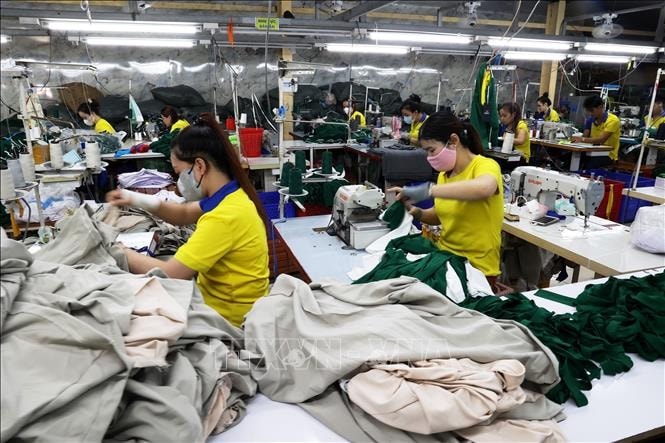The Government has just issued a decree regulating voluntary occupational accident insurance for employees working without a labor contract (referred to as voluntary occupational accident insurance).

Employees subject to this Decree are employees who do not work under a labor contract and are 15 years of age or older, are not subject to compulsory social insurance for work-related accidents and occupational diseases, and voluntarily participate in work-related accident insurance (hereinafter referred to as employees).
2 voluntary occupational accident insurance regimes
Decree 143/2024/ND-CP stipulates the voluntary occupational accident insurance regime including: Assessment of the level of reduced working capacity; Occupational accident allowance.
Decree 143/2024/ND-CP specifically stipulates the conditions for enjoying voluntary occupational accident insurance. Accordingly, employees participating in voluntary occupational accident insurance are entitled to voluntary occupational accident insurance when they meet the following conditions: Having a working capacity reduction of 5% or more due to an occupational accident occurring during the period of participation in voluntary occupational accident insurance; Not falling into the cases of not being entitled to occupational accident benefits prescribed below.
Employees are not entitled to occupational accident benefits if the accident occurs due to one of the following reasons: Conflict between the victim and the person causing the accident that is not related to work or work duties; Employees intentionally self-destruct their health; Use of drugs or addictive substances contrary to the provisions of law.
Decree 143/2024/ND-CP stipulates: Workers who have occupational accidents must proactively go for assessment or re-assessment of their reduced working capacity when they fall into one of the following cases: After the first injury has been treated to a stable level; After the recurrent injury has been treated to a stable level; In cases where the injury cannot be treated to a stable level according to the regulations of the Minister of Health, the worker can go through the assessment procedure before or during the treatment process.
The social insurance agency shall pay the assessment fee for employees who proactively go for an assessment to determine the level of reduced working capacity in cases where the assessment results meet the conditions for receiving or adjusting the level of voluntary occupational accident insurance benefits. The time of payment of assessment fees for eligible cases shall be carried out at the same time as the time of payment of occupational accident benefits.
Work accident benefits
Workers whose working capacity is reduced from 5% to 100% due to work-related accidents are entitled to a one-time allowance as follows: A 5% reduction in working capacity is entitled to 3 times the minimum monthly wage calculated according to region IV as prescribed by the Government (hereinafter referred to as the minimum monthly wage of region IV), then for each additional 1% reduction, an additional 0.3 times the minimum monthly wage of region IV is received. In addition to the above allowance, they are also entitled to an additional allowance calculated based on the number of years of contribution to the Voluntary Work Accident Insurance Fund, from 1 year or less, it is calculated as 0.5 times the minimum monthly wage of region IV, then for each additional year of contribution to the fund, an additional 0.3 times the minimum monthly wage of region IV is received. The period used as the basis for calculating the occupational accident allowance is the total period during which the worker has contributed to the Voluntary Work Accident Insurance Fund, calculated up to the month preceding the month of the occupational accident; if the contributions are not continuous, they are cumulative; A year is counted when there are 12 months of insurance contributions to the Voluntary Labor Accident Insurance Fund.
The time to determine the basic salary of region IV as the basis for calculating the allowance level (hereinafter referred to as the time to receive the allowance) is calculated in the month the employee completes stable treatment and is discharged from the hospital or in the month when the conclusion of the Medical Assessment Council is available in the case of no inpatient treatment. In case of a work-related accident and the time of completion of stable treatment and discharge from the hospital cannot be determined (the discharge paper also includes an appointment for a follow-up examination; removal of the cast; removal of the splint; removal of the screw), the time to receive the work-related accident allowance is calculated in the month when the conclusion of the Medical Assessment Council is available.
The Decree also clearly states that relatives of workers who die due to work-related accidents are entitled to a one-time allowance equal to 31.5 times the minimum monthly wage of Region IV, if they fall into one of the following cases: Workers who die due to work-related accidents while working; Workers who die during the first treatment period due to work-related accidents; Workers who die during the treatment period for work-related injuries without having their working capacity reduced.
Work accident benefits are provided on the principle that each time a work accident occurs, benefits are provided, and accidents that have occurred in previous cases are not accumulated. In case the re-examination results in an increase in the level of work capacity loss compared to the level of work capacity loss for which benefits have been received, the employee is entitled to an additional one-time allowance to ensure that the full allowance is received corresponding to the increased rate of work capacity loss. The time for receiving benefits in this case is calculated in the month of the conclusion of the Medical Examination Council.
The Decree takes effect from January 1, 2025.